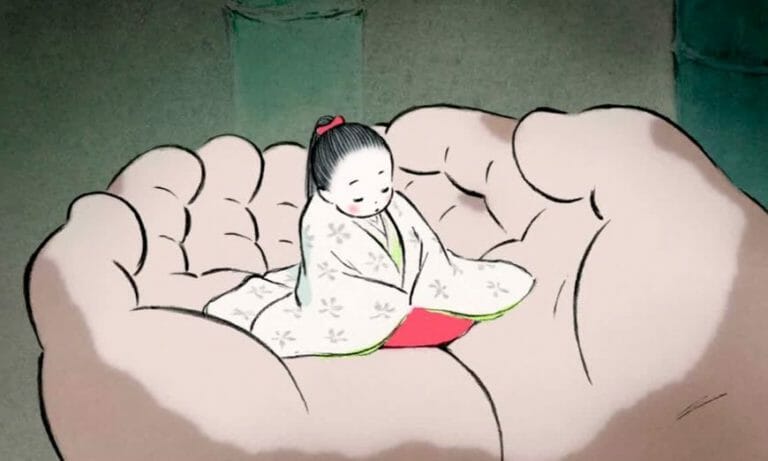By Nguyen Le · February 22, 2015

The Cat Returns, Howl’s Moving Castle, Earthsea, Ponyo, Arrietty, Poppy Hill and The Wind Rises – every post-Spirited Away film from Studio Ghibli continues the company’s tradition of “quality in 2D.” None of them, however, impacts the soul as strong as Chihiro’s journey… until a girl named Kaguya comes along.
Considered to be the oldest tale in Japanese literature, Princess Kaguya follows a girl born on the Moon and her encounters with life’s different shades when an old couple decides to raise her as their own child. At first Kaguya is small enough to fit in a bamboo stalk, but she then rapidly grows into a lady whose beauty dazzles humanity and causes their dark traits to surface.
The material might be fantastical, yet due to the universal themes of womanhood and true happiness, Princess Kaguya’s story is exceptionally grounded. It’s a brilliant decision, then, to leave the film in the hands of Isao Takahata – known for helming Studio Ghibli’s more reflective-of-life films such as Grave of the Fireflies, Only Yesterday and Whisper of the Heart. Moreover, Princess Kaguya introduces viewers to a brand-new art style from the Koganei-based animation house that comprises of partially-finished pencil lines, sparse splashes of color and as few details onscreen as possible. Of course, the intention isn’t to show off, but to achieve the aesthetics of a traditional painting: simple on the outside, but actually exquisite, layered with substance and emotion.
The voice acting, as always, is top-notch. Everybody is emotive and portray the core of their characters in an exceptional manner, with extra credit should be given to actress Aki Asakura. As Princess Kaguya, Asakura – with nothing but pace and pitch – renders joy, regret, innocence and desperation tangible to viewers. Without the unique drawing style, her voice alone can be considered the magic of the film.
As for the music, while it is less varied than Joe Hisaishi’s previous efforts, the fact that each song has depth and heart makes the sameness welcoming rather than boring. The music fully embraces the folktale backbone that defines the story of Princess Kaguya – unsophisticated in nature, but so memorable it’s easy to pass on to others.
That said, research is needed for strangers to Buddhism and Chang’e (the Chinese goddess of the Moon) prior to watching Princess Kaguya. Interesting factor aside, these two elements are important plot points that literally barrel towards viewers in the third act with little to no explanation. The rushness in their introduction and departure is alienating in many ways – the film up to this point has been measured and its images have been relatable.
Without the “Disney push,” The Tale of Princess Kaguya faces tough competition from other animated films at this year’s Oscars. Still, going home with a gold statue or not, Studio Ghibli’s latest deserves a watch not only for the craftsmanship or the heart, but because it’ll be a long while before the logo with Mr. Totoro is seen in cinemas again.
But for this Sunday, here’s all the luck in the world to Kaguya-hime.